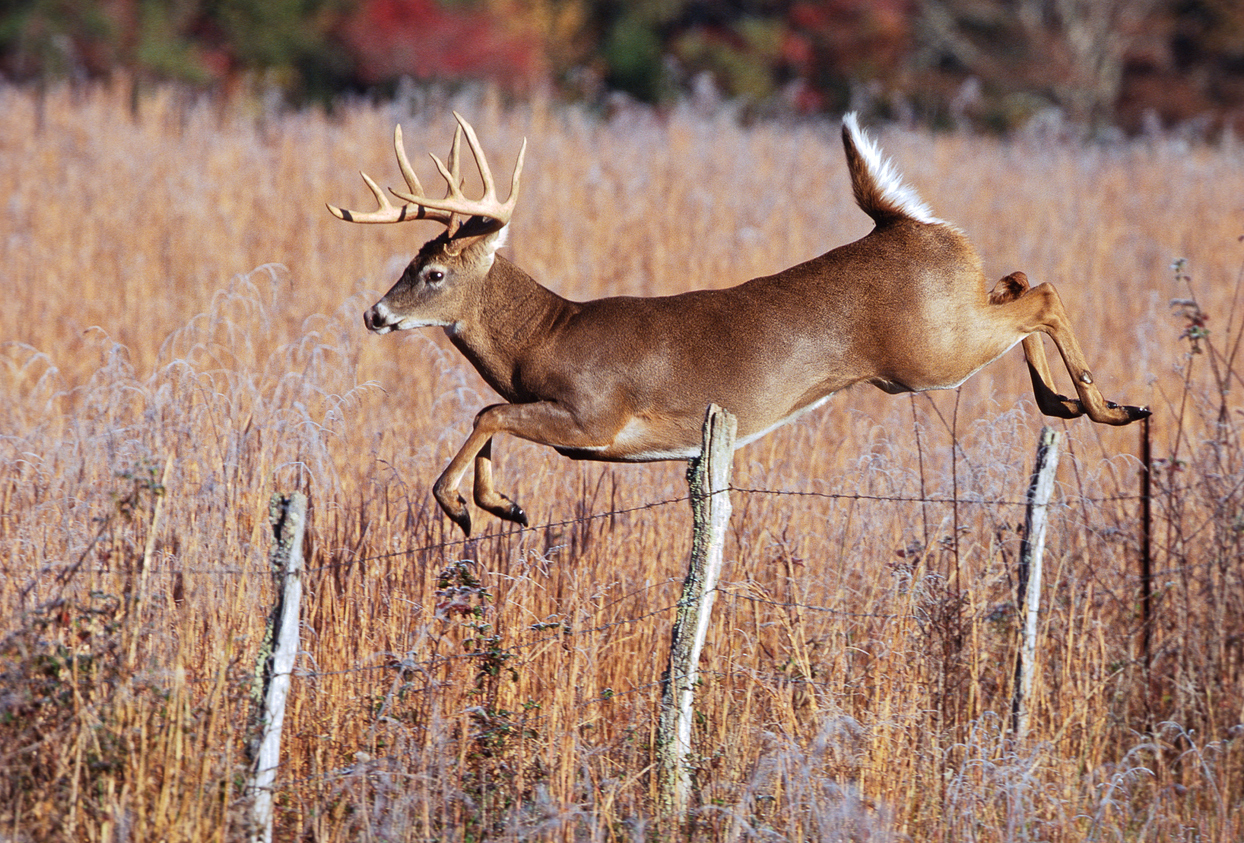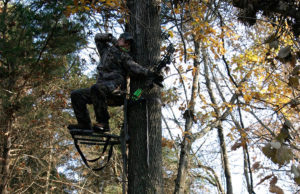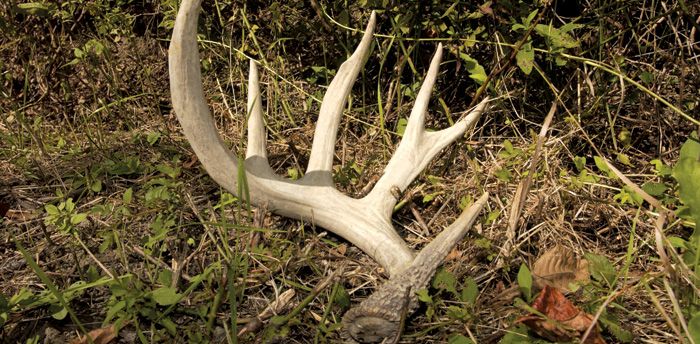Each year, an undefinable thing makes a buck grow healthy new bone from places on his head called pedicles. Some say if we could find out what that thing is, we’d have the cure for cancer.
And what’s the purpose for antlers? The consensus is that they are primarily for fighting and display. Studies have shown that, like us, female deer favor bucks with big racks.
If you’ve ever been fortunate enough to wrap your hands around the antlers of a book-class buck, you probably weren’t thinking about any of that. We deer hunters are fascinated by antlers because big antlers will be connected to the head of an older, wiser buck. Taking such a buck is a milestone and/or reaffirmation of a hunter as skilled, persistent and choosy.
For some people, wrapping a hand around a shed antler is just as big of an accomplishment. These people — and you’ll know them instantly if you go to their houses, where empty large appliance cartons are filled with sheds — live for shed hunting like the majority of us live to hunt the rut.
And here’s the thing. Those crazy shed hunters? It’s a safe bet that most of them have taken really big bucks. While learning where to find sheds, they learned where to find bucks.
The Biology Of Shed Antlers
For the average U.S. buck, antler growth begins in late April or early May. The bucks enjoying the best nutrition start the earliest. Technically, antler growth actually begins in a male fawn when it is four months old and begins to form the pedicle.
The antler grows from the tip as a core of developing bone and cartilage, covered in velvet. To find the necessary calcium and minerals to support that growth, bucks are leaching bone density from their rib cages during this time. In late July, as testosterone levels begin to rise in the buck, the antler begins to harden and the velvet dries up. The bucks rub off the velvet.
What are the triggers for the growth? Biologists and scientists have been researching that for decades. We know that antlers start to regrow in response to photoperiod, or increasing day length, and gradually increasing testosterone levels.
At the end of the cycle, which is about seven months, another of those undefinable things happens. The testosterone level decreases, and a thin layer of tissue that’s between the pedicle and the antler suddenly deteriorates. Once that happens, the antler will drop off within 24 hours. Bucks only drop one antler at a time; the second one might drop off within minutes or as long as a week later. Testosterone levels drops faster in bucks living with poor nutrition.
On average, throughout the country, bucks will drop antlers beginning in mid-December, but there are lots of variables. If the buck-to-doe ratio is heavy with does and a bunch of them are running around unbred after the rut, the bucks will continue in breeding mode and the testosterone levels will remain high. The timing of shedding is also tied to the amount of available nutrition and the buck’s body condition after the rut.
In penned deer, where the variables are controlled, bucks will drop their antlers at approximately the same date each year. In the wild, any change such as a shift in buck-to-doe ratio will affect the timing of the shed. The antler shed occurs earliest in the northern parts of the country, where the rut is generally shorter and more intense.

If you can identify trails along fence rows where deer jump, you may be able to find shed antlers along with identifying significant travel routes. (Photo: iStock)
Shed Hunting 101
Bucks that are 1½ years old have antlers that are about 25 percent as big as they’ll be in his prime. At 2½ the buck displays 58 percent of his possible size; at 3½ the number is 75 percent and at 4½ it’s 90 percent.
Many hunters might have cut their teeth on smaller bucks but now seek only the big boys. Getting out and finding sheds is your first clue that a big buck is in the vicinity and has survived hunting season.
Where to look? After the excitement and tumult of the rut, bucks and does are seeking food, shelter and water. They also want to find places where those things they need are in easy proximity, so they don’t have to expend valuable calories obtaining them.
If you live in a snowy region, it’s relatively easy to find heavily used deer trails. They line up like elephants, walking single file along the same trails. In areas with bare ground, target any food source such as winter forage food plots, grassy fields such as CRP areas and power lines. In the northern states, deer frequent areas where they can find open water.
If it’s legal in your area, set up feeding areas with game cameras. That way you’ll have a look at the antlers bucks are carrying, and also know exactly when the shedding begins. If you can’t feed deer, instead move the cameras to any heavily traveled trails you can find.
In colder months, deer will also seek areas that the sun can reach, such as southern-facing slopes with a tree canopy open enough for rays to reach the ground. Add a few evergreen trees or brush that blocks the wind, and that’s an area that will hold deer during the winter months. During the winter months, the deer will spend the majority of their time bedded, to conserve energy, which is why bedding areas are prime areas for finding sheds.
If any agricultural fields or food plots are standing, you’ll find sheds in the fields and along the perimeters. When you’re checking trails, pay special attention to areas that have features conducive to shed drops — trails traveling through thick cover or under low branches, or places where deer make a jump, such as stream or fence crossings.
Use a map, make a grid
You’re going to put in many miles to find sheds. To be most effective, start your search with a topographical map and a plan. Using the map, pick out those southern exposure areas and look for sheltered areas, especially in the lower elevations.
Using a map will have two advantages. It will allow you to make an organized search of an area, and it will allow you to mark the areas where you find sheds. Your shed-hunting pack should include the map, a GPS (so you can mark shed spots and find your way home), bottled water, binoculars, snacks and other essentials such as dry socks and gloves.
When planning your search, think small. It’s much better to cover a small area thoroughly than to cover a lot of ground. Coach yourself to go slow and keep your eyes down, and take time to check your back trail for another perspective. Try to remember to look for pieces of antlers – sometimes just a tip of a tine sticks up from the leafy forest floor, or from the snow.
“The more the merrier” applies here. The necessity of doing a slow and methodical search to be effective means it’s a great activity for kids.
Don’t be discouraged and don’t be afraid to cover the same ground again. Most avid shed hunters will tell you that it sometimes takes many outings before a shed is found. It’s not easy, but remember to view it as another form of hunting.
Or, you can try creating an antler trap to encourage deer to shed their antlers in a specific spot. This won't be as pinpoint-specific regarding where to hunt the buck next year, but it'll still give you a good idea of where he hangs out.
What To Do With The Knowledge
In order to bag a quality buck, you have to gather as much info as you can about him. The most important thing you can learn about a big buck is where he feels most comfortable. And the second most important thing to learn is how to hunt him without making him the least bit uncomfortable.

Hanging stands early in the year after shed hunting reveals trails or other good intel could help you be more successful during hunting season.
Those shed antler areas — where shelter, food and water are most accessible — are the places where deer go to recover from the rut. They are places where deer feel secure. Often, they are the same places where deer go when they feel hunting pressure; those places will include two key features: cover and security.
Research telemetry collars that record activity prove bucks have an internal core area within their broader home range. No matter what the geography, the core range on average is 15 percent of the size of the home range.
Bucks spend 50 percent of their time in the core range, and for most of that time they are stationary, or bedded. If you’ve found a shed honeyhole, chances are you’ve found a buck’s core area that he uses throughout the year.
Here’s how to apply your shed-hunting knowledge to your hunting tactics. You can be technical and use a topographical map with shed locations marked using GPS; or you can make do with a hand-drawn map. Backtrack from the shed locations to the location of feeding and watering areas available during hunting season.
Before you hang a stand, factor in the prevailing wind direction for hunting season. It's not easy hunting a wise buck. He’s already figured out how to detect danger when he moves from his core. He chose that area because he can move into the wind, sniffing for danger, when he heads to food and water. An elevated stand might not be your best tactic; consider a ground blind with a scent-suppression feature.
If you hang a stand, do it early in the year and try to minimize noise, disturbance to the area and scent. Early spring shed hunting is a great time to scout for stand locations and hang stands, since the amount of available cover mimics what will be around in autumn. Either way, elevated stand or ground blind, also consider your approach to the hunting location.
Find his sheds? You’re so much closer to finding him. You’ve increased the odds that the next time you see his antlers, they might be attached.
What's New In Whitetails
5 best places to find shed antlers
Best hunting apps based on where and how you hunt
Will Netflix's new movie make deer hunters look like buffoons?
How to plant fruit trees for deer







